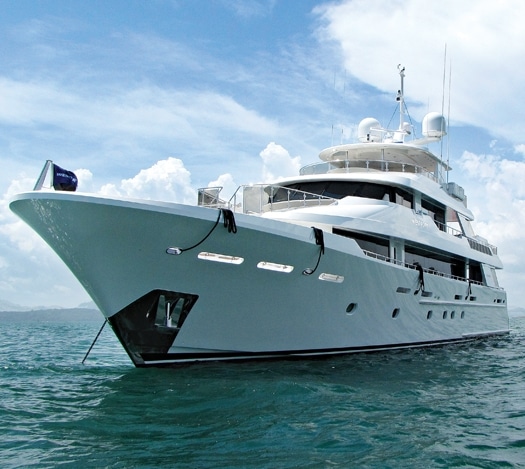
ytgmar26westport525.jpg
I had never made a Panama Canal transit before. Perhaps that’s why I failed to hear the voice of my grandfather, a brigadier general in the Marine Corps, echoing in my memory as he sternly advised “Never volunteer!” And when two writers in quick succession canceled on writing this story, I thought, “Jeez. A brand new, $19 million yacht and a transit of the historic Panama Canal? I’ll do it.”
Okay, it’s not exactly like I crested the top of a hill and went down in a slow-motion hail of enemy gunfire. But my arrival flights had been delayed. I’d missed my connections. My luggage had been lost. It was day four of a planned fiveday trip that was now definitely going to be at least seven days. I’d rescheduled my departure flights twice and it looked like I’d have to do it one more time before we actually made it through the canal. Last but not least – and I was really trying not to think about this part – it looked like I’d have to be put ashore in the early morning hours on the unsavory docks of Colón, Panama. So, a hail of gunfire still wasn’t totally out of the question.
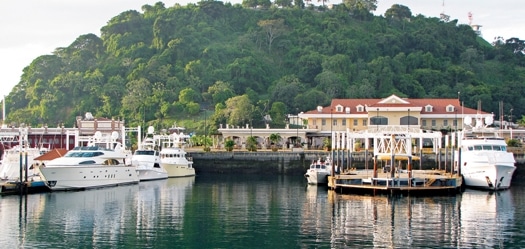
| | |
Now it was Tuesday and pouring. I was sitting in the pilothouse of the Westport 40m at Isla Flamenco Marina Fuerte Amador, off Panama City, and through the veil of a gray downpour, I had a 180-degree view of the port beyond the breakwater, where an assortment of freighters, tankers, sailboats, and even a cruise ship awaited their turns to transit the Panama Canal.
I had joined the delivery crew of seven on Saturday at Los Sueños, in Herradura Bay, Costa Rica. They’d been underway for more than 10 days by then and had traversed the entire West Coast from Seattle, en route to the Ft. Lauderdale boat show. Their shakedown trip was going well so far: They’d lost a part of the windlass in a huge head sea, had some minor generator problems that had since been repaired, and the wireless Internet was only pretending to work. Pretty small stuff when you consider the size and complexity of a shipyard-fresh 130-foot yacht.
Westport would be quick to tell you that they’ve built a great reputation for quality and customer service (and their many repeat customers are quick to agree). Part of that is because building semicustom yachts well is all about eliminating surprise, designing and building, instead, for repeated perfection. The way Captain Fred Hammond put it to me was that Westport is “always thinking one step ahead.” They’re constantly improving their product, sometimes building in extras in advance of needing them, and always with the long term in mind. When talking about the new 40m, which is built on the hull of the hugely popular, William Garden designed Westport 130, Hammond cites this vessel’s ABS-class and MCA-compliance as an example of something they started working quietly toward on previous builds.
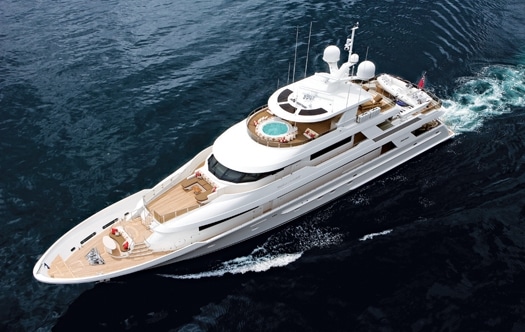
| | |
But, in reality, everything about the 40m makes Hammond’s point. I’d had a couple of days with nothing to do but explore the new model and it was impressive. It’s been reconfigured in a way that extends the sundeck significantly and, in the process, creates a covered, outdoor dining area on the bridgedeck. An all-new one-piece deck mold here has integrated seat bases, a hot tub, coamings, and other elements to create a single unit for structural integrity. The result is a yacht that maximizes its outdoor living areas, whether at sea or at anchor.
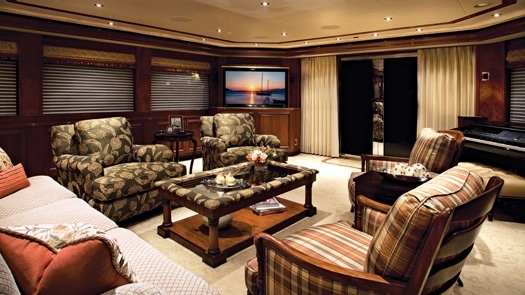
| | |
Inside, though furniture and art were stowed for the delivery transit, Westport’s attention to fit and finish was clear, and despite the lack of places to sit, the yacht oozed comfort. The saloon doors silently opened with a push of a button, large winwindows let in light and views, and the joinery was flawless. Stowage was plentiful in built-in cabinets topped by onyx.
The galley was one of the best I’ve ever seen. Beautifully designed for cooking in a seaway, with a U-shape work area that housed an under-counter Fisher & Paykel stainless steel, drawerstyle dishwasher, a Perlick wine refrigerator, an ice maker, and a deep sink, this space would cradle a chef in even the worst weather. A Gaggenau range was tucked into the starboard corner and a double-door stainless steel refrigerator, also to starboard, rounded out the appliances. Forward of this area was stunning floor-to-ceiling stowage, executed in a herringbone joinery with stainless steel trim. It was a flourish that made the galley as beautiful as the rest of the yacht, despite its impressive practicality.
Guest accommodations were simply lovely. My VIP cabin had windows that allowed in the light, a king berth that was comfortable, the requisite wall-mounted flatscreen television with Kaleidescape entertainment center at the ready, and an en suite head that was finished in a dark marble.
I checked out the engineroom, of course, which was a vast and spotlessly white home to twin MTU 12V 4000s and twin 65 kW generators. Honestly, I’ve lived in much smaller, less comfortable New York apartments. Like all Westports, the 40m comes completely finished, (including furniture, soft goods, etc.) and should only take a little longer to deliver than the 130, which is completed, furnished, and fully ready to go, 75 weeks after signing the contract.
The 40m was running about a knot slower on our trip. Captain Hammond said they were using the delivery run to tweak improvements to the 40m-trying to find ways to get the weight down to improve the fuel-burn rate. “We’ve got 5,000 miles to practice,” he grinned, clearly willing to do his partó maybe because of the way the 40m rides. Hammond says he actually preferred it to the 130, which he loves and has run all around the world, both on deliveries for Westport and for private clients.
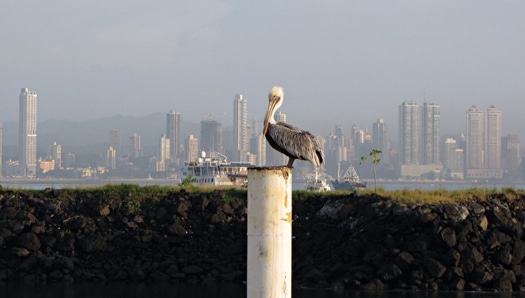
| | |
Wednesday at last brought better weather, so I explored Panama City in the morning, while we waited for night and our turn to enter the Canal. As you get older, you realize that few things live up to your expectations and even fewer exceed them. But when we entered the channel approaching the Miraflores locks, I stood on deck with those members of the crew who were making their first Canal transit and I think our jaws may have dropped in unison. Tiny steel locomotives (known as mules for the work animals they replaced) motored alongside with lines. A massive bulk freighter moved directly ahead of us as various giant fuel and cargo ships passed us in the opposite channel, heading toward the Pacific. When the twin lock gates (which weigh 750 tons each) closed behind us, millions of gallons of water rushed in, in two stages, to float us to 54 feet above sea level, before releasing us into the Miraflores Lake. It was, for lack of a more appropriate word, awesome to be moving through this miracle that man had designed to portage behemoth vessels up and over hills with more ease than he could convey a kayak to a car-top roof rack.
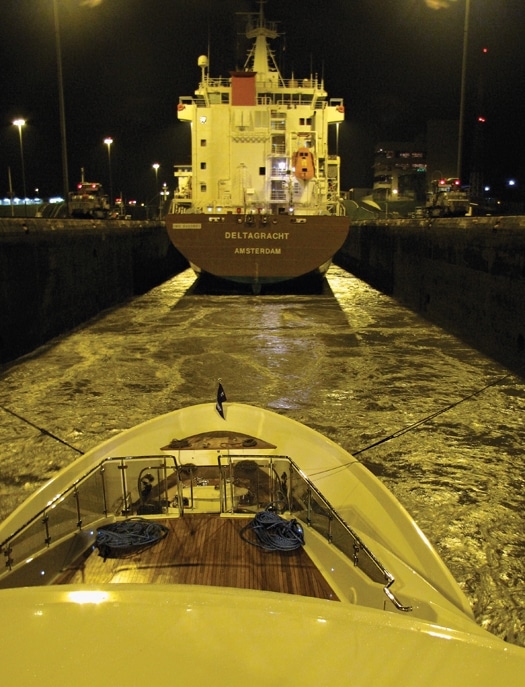
| | |
Several hours later, on the Atlantic side of the canal, I stood on deck in the pitch black of 0200, sea bag at my feet, waiting for the tender that now bounced across Bahía Limón to deliver me to the docks of Colón and God knows what kind of gruesome ending. But I took an admiring look at the Westport 40m and a glance back toward the locks and decided Hell, yes! I’ll volunteer again.
Westport Yachts, (954) 316-6364; **www.westportyachts.com**








